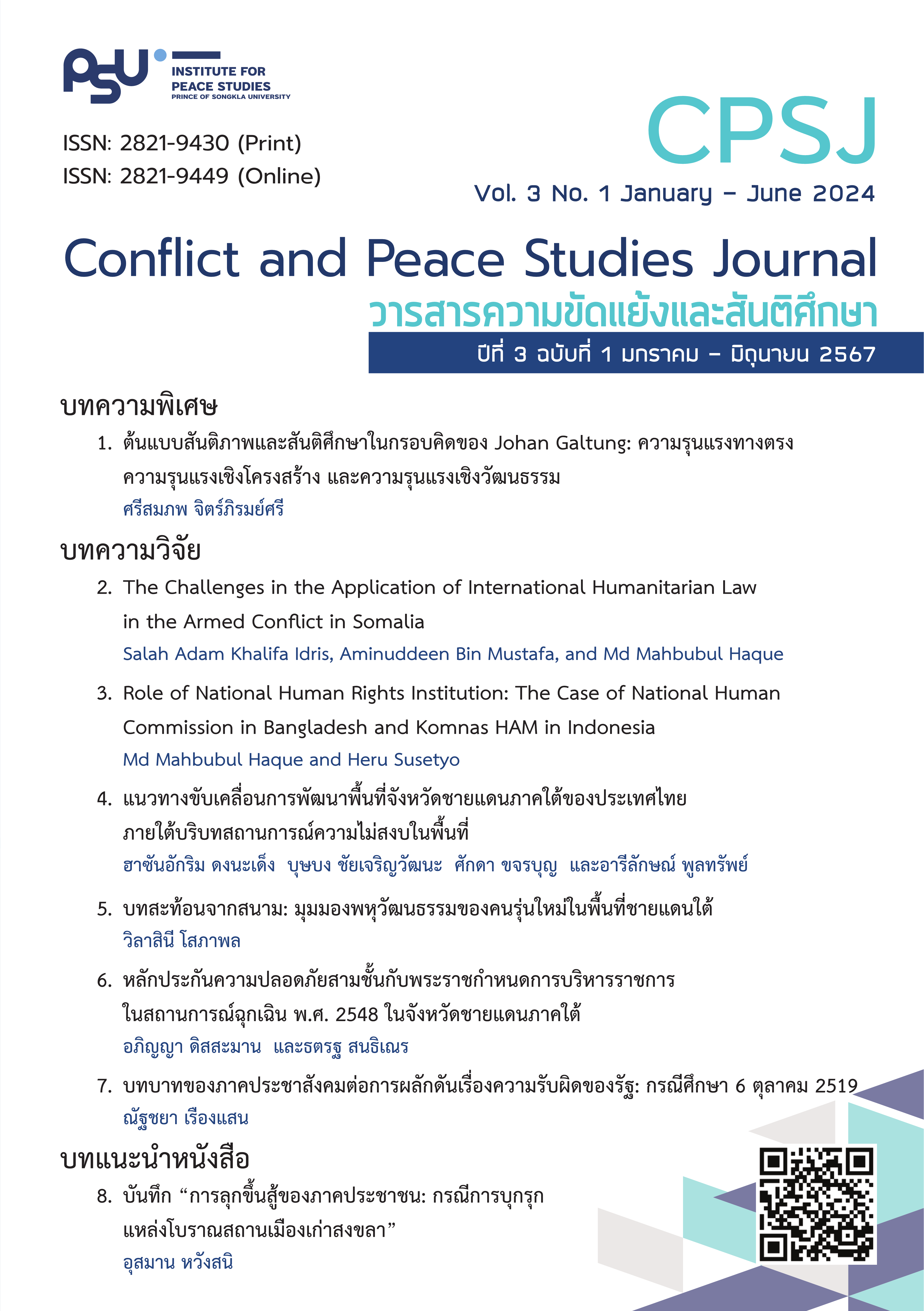The Challenges in the Application of International Humanitarian Law in the Armed Conflict in Somalia
Main Article Content
Abstract
The Eastern African region has a long history of being one of the most volatile geopolitical hotspots for internal unrest and international armed conflict. The root causes of the Somalian protracted armed conflict are economic hardship, abject poverty, and clannism. According to the Appeal Chamber of the ICTY in the Tadic case, armed conflict arises when there is prolonged use of armed force between legitimate government institutions and organized rebel factions located within the same group. This research paper aims to contrast the IHL norms and scope applicable in the Somali armed conflict and its implementation in restoring peace. The study adopted a qualitative method and employed a doctrinal legal approach to critically analyze norms, and doctrines of law in existent legal documents, such as legislations, conventions, law reports, periodicals, and journal articles among others to ensure in-depth comprehension of the related issues about the implementation of IHL in the armed conflict settings. The findings revealed that the negligence of the Somali government hampered the efforts of the international community in providing aid and safety to the hors de combat and vulnerable Somalis affected by the protracted armed conflicts. Some recommendations were offered to the United Nations Security Council and other global actors, to ensure nations uphold IHL norms, in an armed conflict setting, employable to the Somali and other similar armed conflict nations context in ensuring peace and security prevail in Somalia and beyond.
Article Details
References
AfDB. (n.d.). Somalia Economic Outlook. Retrieved from https://doi.org/https://www.afdb.org/en/countries-east-africa-somalia/somalia-economic-outlook
AOAV. (2016). Somalia. Action on Armed Violence. Retrieved from https://aoav.org.uk/2016/somalia
Assefa, H. (1999). A lack of visionary statesmanship and democratic leadership. Searching for Peace in Africa. An Overview of Conflict Prevention and Management Activities, 115-119.
Bayne, S. (2001). The European Union's Political and Development Response to Somalia. ECDPM.
Belay, T. (2019). Somalia: Conflict Insight. Institute for Peace and Security Studies (IPSS). Ethiopia. Retrieved from https://policycommons.net/artifacts/1444113/somalia/2075846/ on 29 Jun 2024. CID: 20.500.12592/ngwstm
Best, G. (2009). The Methods of Conflict Resolution and Transformation in Introduction to Peace and Conflict Studies in West Africa, University of Peace Africa Programme. Ibadan: Spectrum Books Limited.
Castrén, E. (1966). Civil War/Erik Johannes Sakari Castrén. Suomalainen Tiedeakatemia: Helsinki.
Chopra, J. (2014). Report of the Monitoring Group on Somalia and Eritrea pursuant to Security Council resolution 2111 (2013): Somalia.
Conflict With Al-Shabaab in Somalia. (2024). Center for Preventive Action.
Dersso, S. A. (2009). The Somalia Conflict implications for peacemaking and peacekeeping efforts. Institute for Security Studies Papers, 2009(198), 24.
EIP. (2018). The Islamic State of in East Africa. Retrieved from https://www.eip.org/wp-content/uploads/2020/07/Report_IS-in-East-Africa_October-2018-3.pdf
Focarelli, C. (2019). International law. Edward Elgar Publishing. ICRC. (1949). The Geneva Conventions. Retrieved from https://www.icrc.org/en/war-and-law/treaties-customary-law/Geneva-conventions
ICRC. (2004). Advisory Service on International Humanitarian Law.
ICRC. (2019). ICRC report on IHL and the challenges of contemporary armed conflicts.
Lewis, I. M. (1994). Blood and bone: The call of kinship in Somali society. The Red Sea Press.
Marchal, R. (2009). A tentative assessment of the Somali Harakat Al-Shabaab. Journal of Eastern African Studies, 3(3), 381-404.
McDermott, Y. (2012). Double speak and double standards: Does the jurisprudence on retrial following acquittal under International Criminal Law spell the end of the double jeopardy rule? THE CHALLENGE OF HUMAN RIGHTS: PAST, PRESENT AND FUTURE, David Keane, Yvonne McDermott, eds., Cheltenham, Edward Elgar.
Menkhaus, K. (2006). Governance without government in Somalia: Spoilers, state building, and the politics of coping. International security, 31(3), 74-106.
Mundis, D. A., & Gaynor, F. (2006). Current Developments at the Ad Hoc International Criminal Tribunals. Journal of International Criminal Justice, 4(3), 623-658.
OCHA. (2023). Somalia Humanitarian Response Plan (Humanitarian Action Analysis Needs and Response, Issue.
Osman, A. A., & Souare, I. K. (2007). Somalia at the Crossroads: Challenges and Perspectives on Reconstituting a Failed State. Adonis & Abbey Publishers Ltd.
Schaefer, A., & Black, A. (2011). Clan and Conflict in Somalia: Al-Shabaab and the Myth of “Transcending Clan Politics”. Terrorism Monitor, 9(40), 7-11.
Seth, J. G., Liepman, A., & Chandler, N. (2016). Counter Terrorism and Counter Insurgency in Somalia: Assessing the Campaign Against Al-Shabaab RAND Corperation.
Vibhute, K., & Aynalem, F. (2009). Legal research methods. Teaching material. 68-97.

